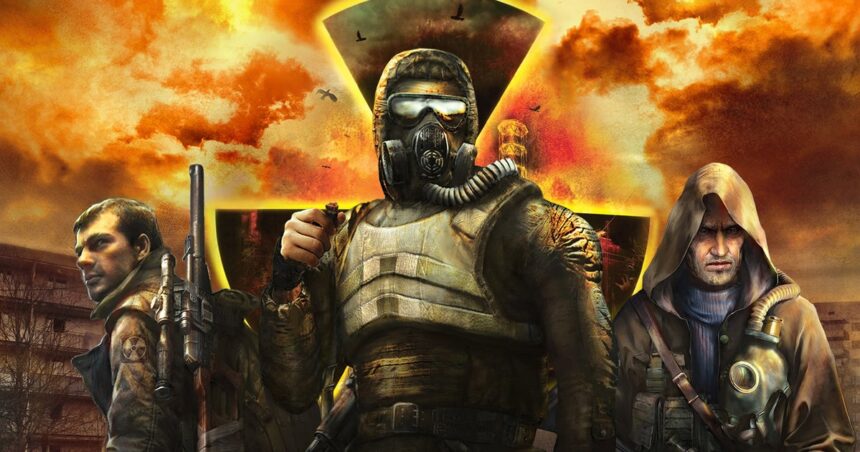A new update for Stalker: Legends of the Zone Trilogy is here, adding a suite of enhancements for those playing on PS5, Pro, PC and Xbox Series consoles. This enhanced edition takes the existing trilogy released on PS4 and Xbox One in March 2024, and embellishes the package even further. In terms of visual upgrades it promises screen-space reflections, improved global illumination, upscaled textures, cutscenes, 3D models, new skyboxes, and god rays. Mouse and keyboard controls are also added on PS5 and Xbox Series machines alongside numerous tweaks and bug fixes. Rounding that out are multiple graphics modes for current-gen machines, letting us run each game at pretty much every reasonable denomination of frame-rate: 30, 40, 60, and even 120fps. So how radical a difference is this enhanced release when compared to the previous version and what’s the best way to play?
To this day, the original Stalker trilogy has a passionate following for good reason. Originally released on PC in 2007, the first game – Stalker: Shadow of Chornobyl – presents a dark, post-nuclear version of events in which you play as a mercenary-for-hire. At its core, Stalker is a first-person shooter but its open-ended design, dialogue trees and inventory menu give it something of an RPG flavour too. It’s also brutally difficult even on the lowest rookie setting, and that comes paired with an equally oppressive atmosphere. Warring clans, and abnormal creatures roam the landscape, forcing you to scavenge every downed foe and every derelict building for better gear in a bid for survival.
The open world was brilliantly brought to life for its time too. Dynamic shadows allow everything including birds overhead to cast shadows to the ground, while weather systems, a day-night cycle, and complex enemy AI all run to their own logic – meaning battles emerge outside of player control. Developer GSC Game World pushed its X-Ray engine towards some cutting edge rendering techniques for 2007 here, with parallax occlusion maps used to chisel out brickwork detail, while also making great use of object physics and body rag dolls.
| 30FPS Quality | 40FPS Balanced | 60FPS Performance | 120FPS Ultra Perf | |
|---|---|---|---|---|
| PS55 Pro | 3840×2160 | 3840×2160 | 3200×1800 – 3840×2160 | 2560×1440 |
| PS5/ Series X | 3840×2160 | 3584×2016 – 3840×2160 | 2400×1350 – 3120×1755 | 2060×1170 – 2560×1440 |
| Series S | 2560×1440 | 2112×1188 – 2560×1440 | 1536×864 – 1920×1080 | NA |
In terms of this enhanced release then, there are upgrades to all games in the Legends of the Zone Trilogy – comprising of Stalker Shadow of Chornobyl, the 2008 prequel Clear Sky and finally 2009’s Call of Prypiat. Comparing the older PC version of the Stalker trilogy, it’s augmented in many key areas. Firstly, you’ll notice pre-rendered cutscenes now present with a higher bitrate 4K encode in each game. These appear to use AI upscaling to hit 4K, and while there are visible artefacts as a result of using a lower res base encode for this upscale, it’s a much-needed improvement.
Next, in terms of actual in-engine gameplay, the improvements are also clear. The existing PC – and indeed PS4 and Xbox One versions from last year – already use upscaled texture assets, and so the enhanced version does little to move the needle in this respect. One standout improvement though is in screen-space reflections – SSR – which add a more detailed mirror image to water bodies. Previously, the official release used basic cube map textures for reflections, but SSR goes a long way to fleshing out the mirror image on lakes and rivers. There’s no ray tracing, but it’s a step forward that rolls out to the PC update as well. Secondly, broad views of the game’s landscapes reveal a huge increase in foliage, geometry and shadow draw distances. The broadened LODs here minimise the visibility of pop-in, especially now we’re playing at resolutions of up to 4K and beyond. The addition of improved GI also affects the indirect shadow and light bounce around trees, simulating a thicker, richer shade across the world – and the small pockets of space around the gun and player’s hand. All of this, again, goes beyond what’s possible in the official PC build maxed out, before the enhanced edition upgrades.
The SSR, GI and boosted world draw are the most notable advantages – but several other points stick out. Global shadows, as produced by sunlight, are visibly increased in resolution – and while they still show pixelation on the enhanced edition it’s still a welcome boost. Likewise, the sky boxes look terrific after the update with a crisp, painterly appearance that addresses the low resolution appearance of the original’s. In other areas, however, like the character models, volumetric effects and textures, it appears we’re getting a match for the best the game had to offer in its previous state. Some bugs also remain even on this latest revision, including odd enemy physics after the finishing gunshot. Overall though, the enhanced version easily represents the best way to jump into these games today on PS5 and Series X.
To see this content please enable targeting cookies.
Speaking of console comparisons, this one is very straightforward. As games released 16-18 years ago, PS5, PS5 Pro, Series X and S all capably run with matching core visual settings across the board. To live up to the ‘enhanced’ label, no platform makes a compromise on those upgrades. Instead, the key means by which these games scale is via their resolution bounds, depending on your console of choice and selected mode. PS5 Pro users enjoy a higher average pixel output from the machine while on the 60fps performance mode, which goes from 1800p to a true 4K. Meanwhile PS5 and Series X run at between 1350p and 1755p, depending on GPU load while Series S settles at a much lower, dynamic 864p to 1080p range while targeting 60fps. The most notable difference between all platforms is precisely this: Series S struggles to match the other three machines in pixels pushed. Especially on the 60fps mode you’ll spot more visual break-up on pylons and fine fence-work at range, resulting in flicker. Another key factor is that Series S loses the 120fps ultra performance option, which is perhaps for the best given how low the resolution might have needed to go to support it.
Fundamentally, there are no visual differences between all four options in settings, with one exception. On the 120fps ultra performance mode, a few extra cutbacks are needed on top of the lowered resolution. Notably we lose SSR altogether on water, and likewise, shadow quality is lowered a setting, resulting in softer, more pixelated shadow outlines. Finally, you’ll notice shadow draw across the landscape is cut back as well.
Hopping over to performance testing, the easiest option to recommend overall is the 60fps performance mode on PS5 systems, Series X and even S. Generally speaking, the DRS range on each platform keeps each stable at 60fps, based on a several hour sample of each game in the trilogy, though obviously there may be much more to contend with as each campaign opens out. As a cursory look, the prospects for this mode look good though, with even Series S holding firm at the 60fps target for much of the time. That being said it’s not 100 per cent blemish free and passages of play are occasionally interrupted with odd single frame dips, while traversal hitches below 90ms are possible at points too. In the very worst case on record so far, I’ve even had a continuous drop into the mid-50s during Call of Prypiat – the third game. In other words, each console trends heavily towards 60fps, but there are single frame blips, spikes and rare moments with drops – the majority of which are, at least, easily cleaned up with VRR technology.




A far less compelling alternative is the 30fps quality mode. On PS5, Series X and S this mode typically renders at a native 4K – and a native 1440p on Series S – but the cost in performance is too dear to justify. Playing such a quick, reactive shooter at 30fps makes no sense, especially given that better options are available. Making matters worse is that this 30fps line is unevenly frame paced on all systems, adding extra judder as you pan the camera. On a similar note, there is a 40fps balanced mode as well, which unlocks if you have a 120Hz display connected. On paper this is a great option to have. It has the same high resolution target as the 30fps mode, but sadly, this also falls prey to uneven frame pacing on PS5 systems. Running at 40fps allows for a snappier 25ms render time per frame, but the added judder incurred by that uneven frame pacing again makes it hard to recommend on PlayStation. That being said, the frequency of frame-pacing issues is greatly minimised on Series X by comparison. In my testing, it’s practically eradicated at 40fps, where we get an even cadence of unique and duplicate frames – and so, for Xbox owners the mode is much easier to recommend.
Rounding out the options is the 120fps ultra performance mode, which is only available on PS5, PS5 Pro and Series X. Visually speaking this targets 1440p on each machine, with base PS5 and Series X dropping to 1170p lowest at stress points – while the Pro model tends to hold at 1440p more regularly. It’s a great idea and does have a practical use case, if you have a VRR display to mask its rough points. Generally speaking play holds at between 100-120fps – and typically the upper end of that range too – but there are notable lurches between those points as the weather changes or enemies pile up. Performance fluctuates at these moments, with single frame dips and intermittent hitches to 45ms and higher thrown in for good measure. Again, this applies to all three systems, including PS5 Pro, where a VRR display will help to reduce the perceptibility of most drops. It’s also worth noting that PS5 systems run with v-sync engaged in this mode, while the Series X version has screen tearing – which the menu warns will be visible if used without VRR. All round, it’s surprising to see such an old game struggling to hold 120fps and it appears the cause is often CPU-related, but it is a welcome option that benefits on a VRR display.
Summarising, the enhanced edition of the Stalker Trilogy spruces up three PC classics for the modern day with mostly successful results. PS5, Series X and S each get some much-needed visual tweaks and new modes into the bargain, making it the definitive way to play today. The only outstanding criticism is on performance: the 60 and 120fps modes have a few rough points even on today’s best consoles, while the 30fps quality and 40fps balanced modes run with uneven frame pacing, curiously excluding Series X at 40fps. The recommended way to play is at 60fps, where most lurches are at least less intrusive to the experience. Still, it shows there have been challenges in adapting the complex, internal logic of these games even to the best console hardware today. For perspective, at least this current-gen release is a huge leap in playability over the last-gen PS4 version. Released last year, Legends of the Zone trilogy on PS4 continues to run at 30fps with uneven frame pacing – and has sizeable traversal hitches to boot. At least on modern systems we have several options to choose between and ways to improve the experience with the right TV setup.





